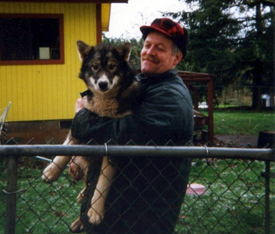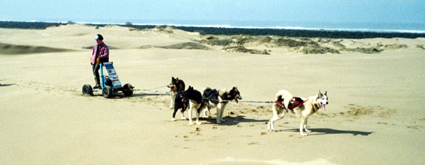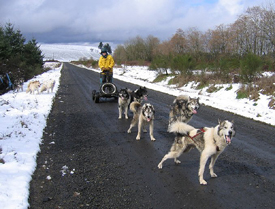In This Issue...
*
FIDO: John Senter
*
Developing a Culture of Mushers
*
The Inuit Sled Dog Registry
*
Arctic Inuit Sled Dogs: Life in Retirement
*
Inuit Dog Thesis Update
*
In the News
*
Fan Mail
*
Kennel Tip: Taking the Heat Off
*
Book Review: The Lost Men
*
IMHO: Filling the Woodshed
Navigating This
Site
Index of articles by subject
Index
of back issues by volume number
Search The
Fan Hitch
Articles
to download and print
Ordering
Ken MacRury's Thesis
Our
comprehensive list of resources
Talk
to The
Fan Hitch
The Fan
Hitch home page
ISDI
home page
Editor's/Publisher's Statement
Editor: Sue Hamilton
Webmaster: Mark Hamilton
The Fan Hitch welcomes your letters, stories, comments and suggestions. The editorial staff reserves the right to edit submissions used for publication.
Contents of The Fan Hitch are protected by international copyright laws. No photo, drawing or text may be reproduced in any form without written consent. Webmasters please note: written consent is necessary before linking this site to yours! Please forward requests to Sue Hamilton, 55 Town Line Rd., Harwinton, Connecticut 06791, USA or mail@thefanhitch.org.
This site is dedicated to the Inuit Dog as well as related Inuit culture and traditions. It is also home to The Fan Hitch, Journal of the Inuit Sled Dog.

John and Ashe Photo: Senter
John Senter
Salem, Oregon, USA
TFH: How long have
you been mushing?
How did you get started and with what breed?
J.S.: I have been mushing since 1981 or so. At
first, my mushing
was not a very serious endeavor and consisted of very
short runs on gravel
roads within a few miles of my home. This was mainly
because my first pickup
truck wasn't reliable enough for trips farther afield.
Later, I got a better
pickup and was able to get to some more challenging areas
to mush, snow
covered trails, to try my hand at sledding. I started out
with Alaskan
Malamutes. I had been told by other mushers that Siberian
Huskies were
easier to train and handle but I was more interested in
malamutes and already
had two. As I had no trained lead dog, I acquired a
retired Siberian Husky
lead dog from a friend. This was a great help in
getting started.
As time passed, I was able to train malamute leaders and
that stage of
the transition was complete. I ran only malamutes until
1996 when we acquired
Ashe, our first Inuit Sled Dog.
TFH: Tell us about
the "journey"
that brought you to ISDs, the process where a kennel
of "other" sled dogs
becomes a kennel of ISDs.
J.S.: My first actual exposure to Inuit Sled
Dogs was
at the 1994 Oregon
Dune
Mushers' Mail Run. where I was privileged to
participate with Sylvia
Feder. She had three ISDs that were quite impressive. I
was running malamutes
at that time and had always enjoyed and appreciated the
malamutes' capabilities.
My first impression of Sylvia's dogs was that they had a
lot in common
with the malamutes I had. That is, they were freighting
dogs, not fast,
but certainly steady and very serious working dogs. They
were more compact
than my dogs. Sylvia's three-dog team could go anywhere
and do anything
that I could with five dogs. By then, my malamutes
were growing old,
and I was seriously considering getting out of mushing
altogether. However,
through Sylvia's friendship, I was able to replace the
malamutes as they
retired with ISDs. My first ISD was Ashe, from Mark and
Sue Hamilton's
'A' litter, about twelve-weeks-old when she got here. My
first impression
was that she might well have been another malamute, and I
treated her as
such. Then, when he was about a year old, I acquired
Bering, from Hamilton's
'B' litter. Like Ashe, I didn't treat him any
differently than a
malamute. From 1996 through 2000, I ran a mixed team of
ISDs and malamutes.
I retired the last malamute after the 2000 Mail Run. At
this writing, I
have four pure ISDs and an ISD/Alaskan cross who is my
leader. If there
are any differences between Alaskan Malamutes and Inuit
Sled Dogs that
I observed, it is that ISDs are generally more eager to
work and their
desire to be dominant is more pronounced. Other than
that, they could
well be the same breed. I believe there are more
similarities between
the two breeds than differences.
TFH: What were
your expectations
getting into ISDs, and what is your assessment of
how those expectations
were or were not met?
J.S.: My expectations were somewhat unrealistic at
first. I
had assumed that, because the ISD is directly from the
Arctic, the inferior
animals would not live to breed and the ones that did
would be essentially
bulletproof. The reality is that they can have medical
problems and various
other issues just like any other dog, especially as they
age. This is not
disappointing, it's just reality. At the end of the day,
they're dogs and
they'll have problems just like other breeds. That said,
the ISDs' work
ethic is amazing, and their desire to be in harness doing
their jobs brings
a lot of satisfaction. Just to be up in the hills on a
logging road somewhere
by ourselves is a delight. I also appreciate their general
size and build.
They're big enough to qualify as 'big' dogs, but not so
large as to be
too difficult to pick up and move around, load into the
boxes, etc.
Yet, they put as much power on the ground as malamutes.
I've given a couple
of demo rides this season to friends and my five dog team
can move three
adults around pretty well, as long as I do my part, that
is, get off and
push once in a while!
TFH: Did you feel
you had to do
anything differently once you owned ISDs than you
had done before having
them?
J.S.: I really haven't done anything radically
different with
the ISDs that I didn't do with the malamutes. I did feed
the malamutes
Eagle Power Formula during the working season and Eagle
Kennel Formula
during the off-season. But I feed the ISDs the Power
Formula year round.
I find the ISDs prefer the higher protein and fat food and
being a "high
intensity" dog, do better on it. Due to the primitive
nature of the ISD,
and their higher energy requirements, I don't recommend
cheaper foods,
especially ones that contain wheat.
I still use the same one-dog-per-kennel arrangement that I always have. This is contrary to typical practice with ISDs, but it's what I have and I use it. I have a half-acre (0.2 hectare) fenced exercise yard for the dogs and they spend time there daily as a group, but they are kenneled at night. I prefer the security of individual kennels as it keeps the dogs separate when I'm not out with them, prevents injury due to fighting and I know that each dog is safe and secure at night. I did have to get used to the ISDs' tendencies to try to dominate each other, that is, start a brawl now and then. I think this is another similarity with the malamutes, but perhaps more pronounced in the ISD. These run to a type: dog 'A' will try to dominate dog 'B' and the fight will be over once the point has been made. Injuries are uncommon with my dogs, and those that do occur have so far been minor.

John and his team, out on the dunes for
The Oregon Dune
Musher's Mail Run Photo:
Feder
TFH: In your
climate, what adaptations
have you had to make for mild weather mushing?
J.S.: In Salem, OR, we don't usually experience
great extremes
of weather. Temperatures during mushing season will run
from +20ºF
(-7ºC) to +40ºF (+4.5ºC). We get a lot of rain and
not a lot of snow. I consider any day below 40ºF (+4.5ºC)
with
a slight drizzle a first-rate day to train my team. I'll
run ten to fourteen
miles in this type of weather, although the colder it is,
the more the
dogs enjoy it. My dogs haven't developed the super-thick
coat that is seen
in the Arctic, so I have no qualms about working them on
short runs on
days up to +50ºF (+10ºC). Fifty degrees (+10ºC) is the
upper
limit, however. Most of my mushing is still done with a
training cart.
I got mine from Jim Tofflemire in North Bend, OR and have
used this cart
since 1989. I ran the '89 Oregon Dune Mushers' Mail Run
using this new
cart, so new that the paint was still tacky. The cart is
especially well
adapted to the coastal dunes, but works quite well on any
other trail or
gravel road. It is simple, safe and rugged. The cart has
four wheels, is
mixed construction of a wood platform and driving bow,
with welded steel
axles and wheel steering. The brake drags on the rear
tires. The tires
are balloon type for good floatation on the sand
dunes. This cart
is also fairly light, so I'll typically drag a tire casing
behind it for
some extra load, especially on shorter runs. Jim markets a
similar cart
called the Sand Lynx .
This winter, we received several snowfalls on my favorite training roads, but it was never deep enough to use a sled. In these conditions, I still used the cart and counted on getting off and running if and when it got too deep. We don't do quite the distance as when the roads are bare, but the dogs still enjoy it and it's a good workout for them. I need the exercise, too!
TFH: Tell us about
training for
and participating in the annual Oregon Dune Mushers'
Mail Run.
J.S.: First, I would recommend anyone who has a
recreational
team of Inuit Sled Dogs to search out some event that will
provide both
satisfaction and a proper challenge to both the dogs and
the musher. This
might be a freighting race, a long-distance, low speed
event, or something
of the musher's own devising, such as freighting camping
in snow country.
Both the dogs and the musher need this challenge. When I
first began mushing
recreationally, I mushed on my own on weekends, a few
miles each day. This
was not much of a challenge. At various times I would be
encouraged by
other mushers to participate in some event that would give
me a goal to
strive for with my malamutes. In my case, that was the
Oregon Dune Musher's
Mail Run. I have participated in eight of these with
malamutes and two
with ISDs. The Mail Run is a two-day event for large teams
and three days
for small teams of three or four dogs. It covers
seventy-two miles (116
kilometers) in the Oregon Dunes Recreation Area on our
coast. Both ISDs
and malamutes do well in this event because the terrain is
often steep
and the sand punchy, perfect for a freighting team to show
their stuff.
Because it isn't a race, blinding speed is not as
important as the ability
of a team to keep going regardless, pull up steep grades,
ford creeks and
ponds, and so on. Only training carts are used for this
event, run largely
over sand dunes. It is not a race, but a fun event
that has as its
purpose funding local racing teams who participate in the
Iditarod.
The Mail Run gave me the focus I needed to train my team
more effectively.
To run this event, one needs to get plenty of miles on the dogs and to develop good leader control. I would try to get in at least one or two short runs of five miles (9 kilometers) or less during the week and longer runs ten to twelve miles (16-19 kilometers) each on Saturday and Sunday. I found that the kind of leader control that sufficed for running a logging road and making an occasional turn at an intersection was not enough for the dunes, where much of the area is essentially wide open and trackless. Good control is needed to avoid falling off a steep dune or to skirt a pool of quicksand - no kidding!
TFH: Any closing
thoughts?
J.S.: I have truly enjoyed being involved both with
the ISD
and the malamute. I've never done anything especially
earth-shaking with
either breed, but I've had some great fun, met some great
people and had
some great dogs. I would recommend the ISD to any
recreational musher who
is committed to learning the idiosyncrasies of these dogs
and who, above
all, is committed to working them. They are not for the
timid, but they
are very rewarding.

On the logging
roads
Photo: Feder